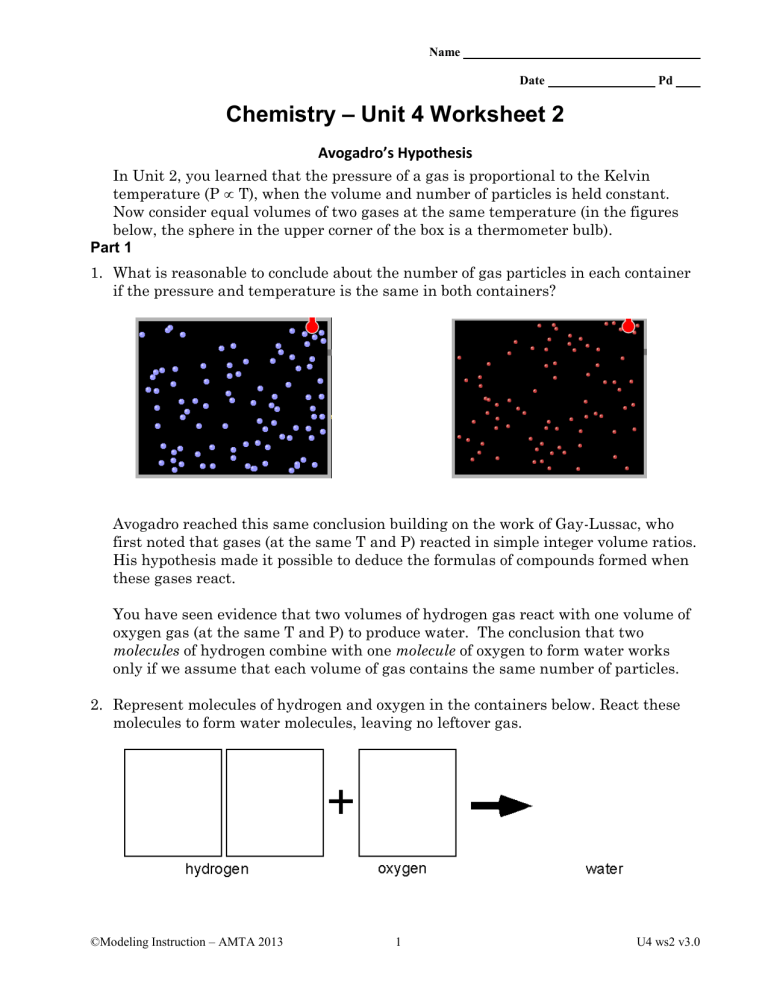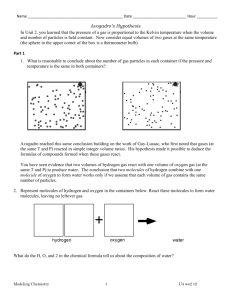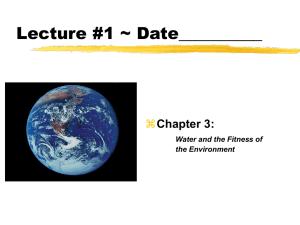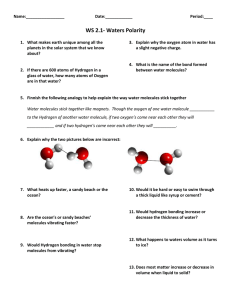
Name Date Pd Chemistry – Unit 4 Worksheet 2 Avogadro’s Hypothesis In Unit 2, you learned that the pressure of a gas is proportional to the Kelvin temperature (P T), when the volume and number of particles is held constant. Now consider equal volumes of two gases at the same temperature (in the figures below, the sphere in the upper corner of the box is a thermometer bulb). Part 1 1. What is reasonable to conclude about the number of gas particles in each container if the pressure and temperature is the same in both containers? Avogadro reached this same conclusion building on the work of Gay-Lussac, who first noted that gases (at the same T and P) reacted in simple integer volume ratios. His hypothesis made it possible to deduce the formulas of compounds formed when these gases react. You have seen evidence that two volumes of hydrogen gas react with one volume of oxygen gas (at the same T and P) to produce water. The conclusion that two molecules of hydrogen combine with one molecule of oxygen to form water works only if we assume that each volume of gas contains the same number of particles. 2. Represent molecules of hydrogen and oxygen in the containers below. React these molecules to form water molecules, leaving no leftover gas. ©Modeling Instruction – AMTA 2013 1 U4 ws2 v3.0 What do the H, O, and 2 in the chemical formula tell us about the composition of water? 3. In like manner, represent particle diagrams that account for the fact that one volume of hydrogen combines with one volume of chlorine to form hydrogen chloride. What do you suppose is the formula of hydrogen chloride? 4. Represent the reaction in which one volume of nitrogen gas reacts with three volumes of hydrogen gas to form ammonia. What is the formula for ammonia? Part 2 Chemists occasionally found that one volume of gas A reacted with one volume of gas B to produce two volumes of gaseous product. Early chemists like Gay-Lussac, were unable to account for this behavior of gases. Avogadro’s key contribution was that he reasoned that the molecules of some gaseous elements must contain two atoms. 5. Consider the reaction between hydrogen and chlorine. Two volumes of hydrogen chloride are formed. Sketch particle diagrams consistent with Avogadro’s Hypothesis to represent this reaction. Explain why hydrogen and chlorine molecules that have only one atom each cannot account for the observed behavior. ©Modeling Instruction – AMTA 2013 2 U4 ws2 v3.0 6. When two volumes of hydrogen gas react with one volume of oxygen gas, two volumes of gaseous water are formed. Modify the diagram you made for #2 to represent molecules of hydrogen, oxygen and water in this reaction. Explain why molecules of oxygen must have an even number of atoms. 7. Two volumes of nitric oxide react with one volume of oxygen gas to form two volumes of a reddish-brown gas. Deduce the formula of this gas and sketch particle representations of its molecules. ©Modeling Instruction – AMTA 2013 3 U4 ws2 v3.0







